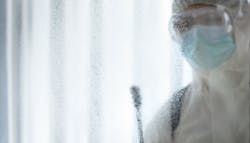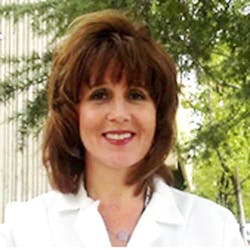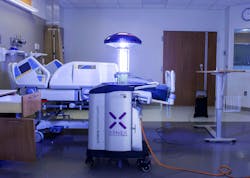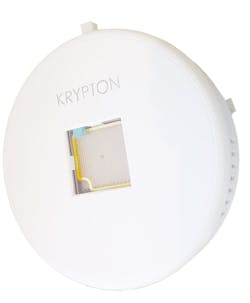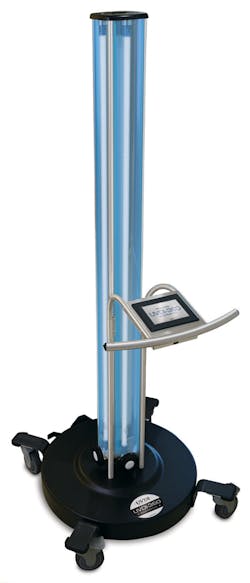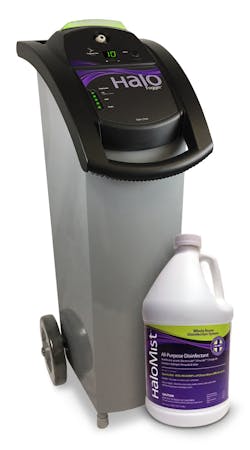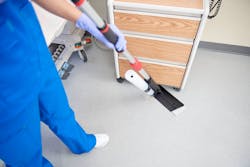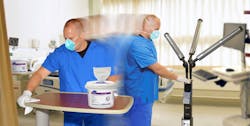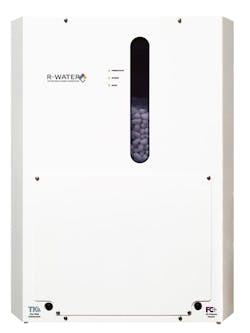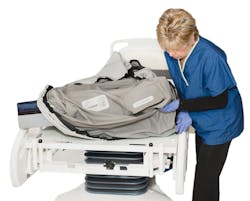Wiping out pathogens with multi-area cleaning
Infections and deaths from COVID-19, caused by the virus SARS-CoV-2, continue to soar throughout our communities. Many people stay home, limit contact with others and hope to not get infected. But what if an emergency health situation arises and a hospital visit is needed?
For vulnerable populations, such as senior citizens and individuals with serious, underlying or immune-compromised health conditions, delaying or forgoing emergency care can cause harmful complications, or even deaths. That can be equally dangerous for people who are experiencing heart attacks, strokes or other life-threatening events.
“A recent poll by the American College of Emergency Physicians found that 29 percent of adults have avoided medical care because they are concerned about contracting the virus,” shared Tom Mihaljevic, M.D., Cleveland Clinic CEO and President, in his online message to patients. “Hospitals nationwide have seen a 38 percent decline in the number of patients presenting with heart attacks across the United States. This is extremely concerning, especially for patients with heart disease and cancer, who require early screening, constant surveillance and treatment. If you have a medical emergency, do not hesitate to call 911 or go to your nearest emergency department.”1
Ensuring safe spaces
The guidance is clear, however, from hospitals, healthcare facilities and medical associations, that it is currently safe for patients to go into medical settings for care. These facilities also are restarting elective surgeries and treatment, but with an eye of caution.
The American College of Surgeons (ACS) guidance states, “Although this document, ‘Local Resumption of Elective Surgery Guidance,’ provides principles to help local facilities safely resume procedures after COVID-19 peaks locally, there is still much work to be done. While COVID-19 cases may have peaked in certain areas, the virus is still circulating and there is much we don’t know about the etiology and progression of the disease.”2
To help keep patients, loved ones and staff safe, Cleveland Clinic and other facilities nationwide are following federal healthcare guidelines and putting protective measures in place.
“Cleveland Clinic has been limiting visitors, delaying some surgeries, providing proper personal protective equipment for caregivers, disinfecting surfaces, practicing physical distancing and screening patients and caregivers for COVID-19 symptoms including taking people’s temperatures at building entrances,” Dr. Mihaljevic continued in his message. “As we resume clinical services, we will continue to ensure that our patient waiting areas are reconfigured for safety.”
Other considerations for visitors to healthcare settings, according to guidance from the Centers for Disease Control and Prevention (CDC), include, “Visitors should only visit the patient they are caring for and should not go to other locations in the facility. Facilities should provide education on appropriate PPE use, hand hygiene, limiting surfaces touched, social distancing, and movement within the facility. Facilities should consider the need to conduct active screening for visitors with potential exposure to SARS-CoV-2 due to a breach in infection prevention and control (IPC) protocol.”3
Concentrated cleaning and infection prevention
Hospitals and other highly susceptible settings for viral, disease or healthcare-associated infections maintain an increased focus on cleaning, disinfection and infection prevention during COVID-19. This may require adjusting supplies and equipment, conducting training for environmental services (EVS) staff, performing a variety of techniques, conducting frequent routines and covering many areas for adequate decontamination.
Disinfecting spaces
There has been a longtime commitment of cleaning along with a need for additional support to safely disinfect healthcare environments, emphasizes Sarah Simmons, DrPH CIC FAPIC, Senior Director of Science, Xenex Disinfection Services.
“Hospital Infection Preventionists and EVS directors have been pleading for years for resources and new technology to enhance environmental cleanliness and battle deadly pathogens in their facilities,” Simmons said. “Nearly 300 people die every day in the U.S. from an infection they contracted during their hospital stay – and that was before COVID-19.”
“We’ve seen a lot of innovation from hospitals and healthcare facilities as a result of COVID-19,” she continued. “Hospitals moved LightStrike disinfection robots from their ORs to the Emergency Departments, so they could immediately disinfect rooms and areas where suspect patients were being treated. We were in a Texas hospital recently when they learned someone in their Accounting department tested positive for COVID-19. They immediately sent a LightStrike robot from the ER to Accounting to rapidly disinfect the entire area and conference room. The LightStrike robots have been proven effective against SARS-CoV-2, and our pulsed xenon UV light achieved a 99.99 percent level of disinfection in two minutes.”
Patrick J. Piper, President and CEO, Far UV Technologies, Inc., sees hospitals, medical and dental clinics and other healthcare facilities reassessing and improving processes and tools to aid in patient and staff protection.
Widespread cleaning in many areas to decontaminate hard surfaces is an extra focus and an additional layer of protection for facilities, stresses Steven Baiocchi, Chief Operating Officer, Steriliz, LLC.
“Their (healthcare front line workers) understanding of unseen risks in the environment prior to and during the pandemic has driven widespread use of enhanced environmental hygiene protocols and solutions like our UVDI-360 Room Sanitizer, which is now used in 25 countries,” Veloz said. “In addition, emerging research about the virus’ persistence and transmission on surfaces has increased interest in hands-free disinfecting practices, which can limit person-to-person and person-to-surface exposure. The UVDI-360 Room Sanitizer is proven in independent lab testing to inactivate over 35 pathogens, including coronavirus. UVDI-360 can disinfect a typical patient room in 10 minutes and a bathroom in five minutes, enabling rapid room turnover while not disrupting workflow. It can be easily activated remotely via an app or directly from the device.”
Disinfection systems can extend into long-term care settings and emergency vehicles for added protection for residents, staff and first responders, points out David St. Clair, Chairman and CFO, Halosil International.
Sanitizing surfaces
Healthcare supply and equipment shortages have plagued hospitals and facilities amidst the pandemic, which has led to greater resourcefulness and flexibility with cleaning and disinfection products and use, explains Ben Oberle, Healthcare & Education Marketing Manager at 3M Commercial Solutions Division.
“They (healthcare facilities) are having to adapt to industry-wide product shortages on the products they’ve always relied on to get their jobs done well,” Oberle stated. There is a heightened focus on ensuring proper usage of products and promoting transparency to patients and staff on cleaning and maintenance practices. Our disinfectant chemicals are being paired with mops and tools to clean and disinfect throughout healthcare facilities.”
Marc-Oliver Wright, MT(ASCP), MS, CIC, FAPIC, Professional Disposables International, Inc. (PDI), emphasizes the concentration on disinfecting many area and items, changing cleaning products and providing staff education.
Leveraging the right roles, products and work routines can help raise the speed and effectiveness of cleaning and disinfection, notes Larinda Becker, Healthcare Marketing, Diversey, Inc.
“There are many considerations to ensure optimization including clearly defined roles and responsibilities, the right tools to do the job to ensure compliance and efficiency, and validation programs to improve processes and focus on ongoing training,” Becker indicated. “Diversey’s Oxivir disinfectant cleaners are fast and effective against pathogens of concern. In addition, the MoonBeam3 disinfection technology has been implemented across many facilities globally, adding UV-C disinfection for added assurance. MoonBeam3 is highly effective with fast cycle times, streamlining workflows. It is easy to use, offers safety features and is portable and easy to store and transport.”
“Electrostatic spraying is a well-established technology with a history of use in other areas, including agriculture, automotive and tanning industries,” Dr. Velez stated. It has only recently been applied to surface disinfection. This technology is a new way to apply cleaners, sanitizers and disinfectants to surfaces, in less time than it would take to apply the same products manually. The Clorox Total 360 electrostatic sprayer is designed to apply disinfectants and sanitizers on all sides of hard-to-clean surfaces and equipment, such as portable equipment and wheelchairs. The system uses patented technology to charge the disinfectant solution, which causes disinfectant droplets to stick to surfaces and consistently coat all surfaces for comprehensive coverage.”
Implementing an environment-friendly disinfection system has resulted in killing pathogens quickly, preparing rooms faster and enhancing patient and staff safety and satisfaction, shares Liz Shelton, Administrative Director, Hospital Operations, CHRISTUS Trinity Mother Frances Health System.
“We received our second machine in mid- to late-March, when COVID was first impacting Texas,” she continued. “These two systems helped us ensure an adequate supply of disinfectant for our ORs, hospital and clinics. Because the system produces disinfectant on-site, we’re able to reuse supplies and reduce waste. Plus, because it (R-Water’s disinfecting solution) is not toxic, it can be disposed of more easily. We just deployed R-Water in our clinics. The nurses love it and feel safe. We significantly decreased our cleaning times by using R-Water, and that allows us to spend more time treating patients.”
Protection of mattresses, where patients spend most of their time, requires a specialized barrier that can help shield patients from infection risk, expresses Bruce Rippe, CEO, Trinity Guardion, LLC.
“Some hospitals are using more rigorous techniques particularly after COVID-19 discharges, such as more frequent cleaning of patient rooms and use of stronger disinfectants during terminal cleaning,” Rippe noted. “Stronger disinfectants can damage mattress skins and mattress cores – and damaged mattresses increase the infection risk for patients. That’s why ECRI sounded the alarm on mattress contamination, citing it as a top health hazard in 2018 and 2019.”
“Trinity’s product is designed specifically for the healthcare mattresses of today, which have changed from vinyl (hard /non-porous surface) to polyurethane (soft /porous surface),” he added. “Our launderable bed barriers meet and surpass the required disinfection guidelines. We leverage a high-heat laundry process. As a result, beds and mattresses are cleaner when compared to more traditional disinfection methods – and the risk of cross-contamination is eliminated.”
References:
- As Services Resume, Our Hospitals Remain Safe: A Message from Cleveland Clinic CEO, President Tom Mihaljevic, M.D., https://newsroom.clevelandclinic.org/2020/05/04/as-services-resume-our-hospitals-remain-safe/
- COVID-19: American College of Surgeons releases new guidance document to help health care facilities best prepare for resuming elective surgery, https://www.facs.org/media/press-releases/2020/resuming-surgery-041720
- Management of Visitors to Healthcare Facilities in the Context of COVID-19: Non-US Healthcare Settings, https://www.cdc.gov/coronavirus/2019-ncov/hcp/non-us-settings/hcf-visitors.html
Have a thought or question about this topic? Write to us at [email protected].
Crisis to crystal ball
Learning from the COVID-19 pandemic, what do you envision for the future of hospital and healthcare cleaning and disinfection? HPN shares these insights from industry professionals.
“The reality of COVID-19 and fear of an inevitable future outbreak have significantly heightened demand for new technologies and processes for mitigating the spread of dangerous pathogens. These will ultimately need to address air AND surface contamination in the safest, most effective and economical way. The biggest surprise for many may be that adopting alternative technologies like Krypton disinfection lighting sooner would have saved a considerable amount of money and lives for the healthcare providers, their patients, the insurance companies and federal and local governments, with or without the pandemic. This realization is leading to important additional investment now and going forward, which will significantly mitigate, if not eliminate, both the risks we were facing before as well as tomorrow when the next inevitable pathogen arrives.”
Patrick J. Piper, Far Uv Technologies, Inc.
“We hope that the COVID-19 pandemic will spur an investment in public health and empower hospital infection preventionists and EVS directors to get the budgets they deserve to make infection prevention a priority.”
Sarah Simmons, Xenex Disinfection Services
“Make sure you have the proper tools and disinfection processes and procedures in place today to protect patients and frontline workers tomorrow. We expect a more focused, better prepared approach to environmental cleaning and disinfection. Hospitals and other public places will have a greater appreciation for Infection Prevention and Environmental strategies that can measure results and hold people accountable. Increasing sophistication in UV disinfection and complementary cleaning technologies will improve cleaning, disinfection, staff safety and patient outcomes.”
Steven Baiocchi, Steriliz, LLC
“I expect healthcare facilities will improve disinfection practices across a number of high-traffic environments moving forward. When COVID-19 case counts began to rise, our early customers had the disinfection systems in place to rapidly and effectively eliminate pathogens. Just as healthcare facilities are increasing stockpiles of PPE in response to the severe global shortage at the onset of the pandemic, so too should they be investing in a disinfection system that can be immediately available in the event of a public health crisis.”
David St. Clair, Halosil International
“When speaking to our customers, we hear that the future will include more conversations around how they can incrementally improve the cleaning and disinfection process, knowing that things like product supply will be a larger part of the discussion. The COVID-19 pandemic has reaffirmed for the industry that things can change quickly and having a backup plan for a worst-case scenario is something all facilities should have. The need to be nimble has created a reason to evaluate the current supply chain and determine what alternatives are available when supply becomes a concern. Lastly, this pandemic has forced facility leaders to think about how they communicate with their teams as well as how to promote the safety of their staff and essential workers, so they can continue to do what is best for everyone in their facility.”
Ben Oberle, 3M Commercial Solutions Division
“Healthcare facilities have been tested through this pandemic on a number of fronts, which will serve as key learnings for the future:
- Determining if they have products that are efficacious against key pathogens of concern.
- Ensuring that they have enough product and PPE available for their staff.
- Ensuring that their supply chain is flexible enough to address future crises.
- Deploying processes that keep staff, residents and patients safe, including evidence-based cleaning and disinfection processes, staff monitoring and validation tools, to continuously improve processes and target training, and, as needed, adjunct disinfection processes, like UV-C disinfection, to address any variability in practice.
Having the staff prepared as well as adequate inventories, protocols and best practices will help to maximize safety in the healthcare environment. Establishing an emergency management system to address a public health crisis and protecting staff and patients is a priority.”
Larinda Becker, Diversey, Inc.
“In the near future, we will likely continue to use automation and new technologies to better clean and disinfect, and to help meet the requirement for higher frequency cleaning brought on by the pandemic. Electrostatic technology is just beginning to scratch the surface of pandemic and post-pandemic disinfection. I also believe that the cleaning regimen will be different, including additional accountability from all parties. For example, electrostatic technology can be used by the professional team for conditioned deep cleans, but we will likely also see building occupants doing their part to keep spaces clean.”
Katherine Velez, Clorox Healthcare
“To better prepare for any possible future public health crisis or even a second wave of COVID-19, hospitals and healthcare facilities need to now develop written policies and protocols, outline a schedule for cleaning frequency and accountable discipline by area and educate staff who perform cleaning tasks. We need to get back to basics, such as strict adherence to product instructions for use, cleaning methodically around the room (clockwise or counterclockwise), cleaning from high-to-low and avoiding cross contamination by cleaning from clean-to-dirty. The CDC also recommends using products with EPA-approved emerging viral pathogens claims against SARS-CoV-2 (e.g., EPA List N). Facilities should have a robust supply of these disinfecting products in stock.”
Doe Kley, Clorox Healthcare
“Infection control must always be at the forefront of the strategic plan of the hospital. As new infectious agents appear, the processes must already be providing high-level disinfection. Organizations cannot wait for a new infectious agent to appear to start improving processes. Also, there must be recognition by hospital leadership of the heightened role that environmental services play in combating infection risks that were highlighted during the pandemic.”
Edmond Hooker, clinical advisor to Trinity Guardion
“Increased focus on supplemental disinfection strategies to augment the manual cleaning and disinfection needed to remove organic soilage. More environmentally conscious approaches to disinfectant development, distribution and use and more “set it and walk away” strategies to optimize human capital. Expansion and broader adoption of continuously active disinfection products that continue to kill microbes between cleaning opportunities. More reliable, reproducible and quantitative assessments of cleaning and disinfection of surfaces for quality assurance.”
Marc-Oliver Wright, Professional Disposables International, Inc. (PDI)
“A continued effort toward advanced and automated disinfection technologies that supplement the amazing job cleaning staff do every day. I also expect we’ll continue to see momentum toward the internet of things, just as we have at home with devices that can clean our houses on their own or allow us to re-order groceries by voice. Specifically, I anticipate more seamlessly connected devices that operate, transfer data and talk to each other more autonomously. The pandemic has widened the broader public’s adoption of the core Infection Prevention best practices that healthcare professionals perform every day. The increased focus on enhanced environmental hygiene and frequent handwashing, in particular, can be of great benefit on an ongoing basis.”
Peter Veloz, UltraViolet Devices, Inc. (UVDI)
About the Author

Ebony Smith
Ebony Smith was previously Managing Editor for Healthcare Purchasing News.
